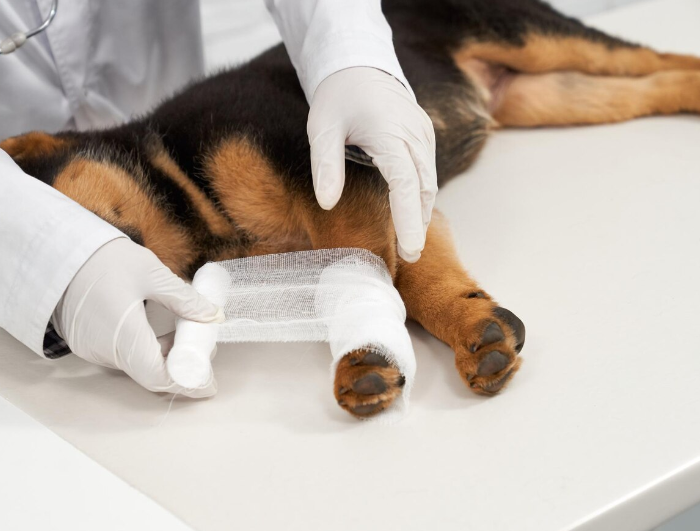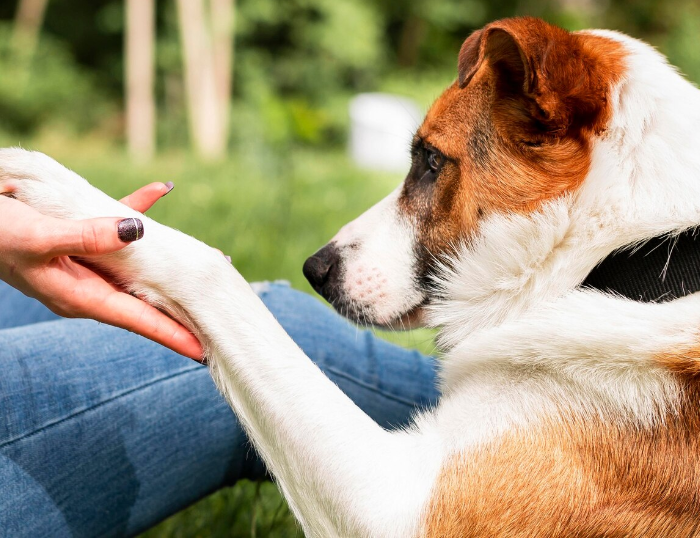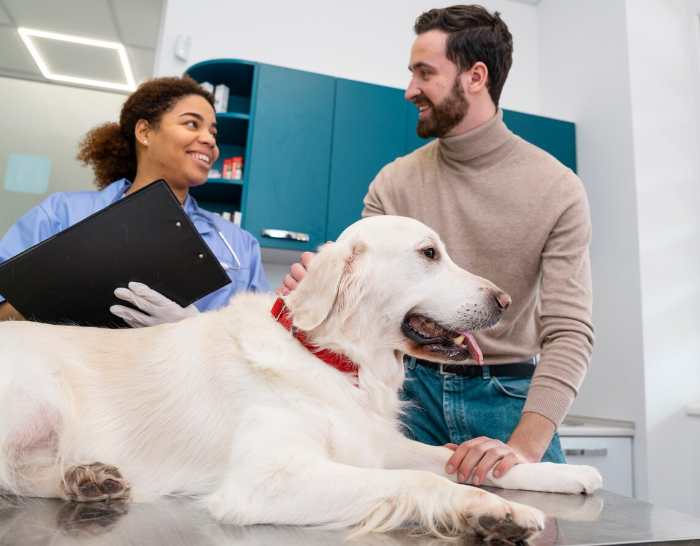2024-05-20
All pet parents strive to provide their beloved fur friends with the best living conditions, ensuring they live healthy and happy lives! We try to feed them food of high quality or even prepare them homemade food; bring them to regular vet check-ups; and provide mental and physical stimulation to keep their mind and body sharp!
When talking about quality of life, we need to add “mobility” as an essential aspect of it. Dogs and cats rely on their ability to move freely to explore their environment, interact with their owners, and engage in physical activities like play sessions and exercises.
Unfortunately, just like humans, pets can also develop mobility issues that can significantly impact their well-being. Understanding these issues, their causes, symptoms, and potential solutions is essential for pet owners to ensure their paw companions lead healthy lives!

You can not run away from your DNA! This is valid for both humans and pets.
Genetics plays a significant role in determining a pet's predisposition to joint issues like arthritis. For example, certain breeds like the Labrador Retriever, Golden Retriever, and German Shepherd are more prone to developing mobility conditions like hip dysplasia due to inherited traits. Small dog breeds like the Dachshund, on the other hand, are predisposed to conditions like intervertebral disc disease.
Understanding your dog’s genetic background can help predict and manage potential joint problems in the future.
Also, it is important to note that the likelihood of developing mobility issues is often higher in purebred dogs, where certain genes are more concentrated due to selective breeding practices.
When choosing a puppy as your new family member and potential service dog, make sure to familiarize yourself with both parents’ health certificates. This will help you exclude potential genetic-related health conditions in the future.
Aging is a natural process that, unfortunately, leads to health complications, including gradual degeneration of joints and cartilage.
As pets grow older, their joints wear out, which leads to conditions like osteoarthritis. Regular veterinary check-ups and appropriate preventive care become crucial for our pets’ well-being, as they help address and manage any age-related conditions promptly.
“This will be the last treat I am giving them today, I promise!” Your family members or yourself may have already said that many times while feeding your fur buddy. While it can be extremely difficult to resist the temptation to give our doggo or kitty a delicious treat, it is important to not overfeed them.
Obesity is a significant risk factor for arthritis and mobility issues in pets, as excess body weight leads to an increased strain on the joints. This particularly applies to weight-bearing body areas like the hips, knees, and spine. Over time, this increased pressure leads to joint inflammation, cartilage damage, and accelerated joint degeneration.
Weight management through proper nutrition and exercise is crucial for preventing and managing obesity-related arthritis in pets.
Traumatic injuries to the joints, such as fractures and dislocations, can predispose our beloved canines and felines to arthritis later in life.
Even after the initial injury heals, remaining damage to the joint structures may lead to chronic inflammation, increasing the risk of developing mobility issues. Proper diagnosis, treatment, and rehabilitation are essential to minimize potential mobility issues following joint damage.
Activities that involve repetitive motions or overexertion can strain the joints and contribute to the development of mobility issues. For instance, working dogs, athletic pets, or those engaged in activities like agility training or jumping may have their joints wear over time.
Managing exercise intensity, incorporating time for rest, and providing appropriate warm-up exercises can help reduce the risk of joint injuries and arthritis in active dogs.
When talking about “mobility”, we often tend to take only the physical aspect into account, forgetting the importance of proper nutrition for our paw friends’ well-being!
Nutritional imbalances or deficiencies can impact bone and joint health, increasing the likelihood of arthritis and other mobility issues in our beloved pets. Diets that lack essential nutrients like calcium, vitamin D, and omega-3 fatty acids can impair bone development and cartilage maintenance, predisposing pets to joint problems.
However, don’t forget that excessive calorie intake leads to gaining weight, which, in turn, can easily increase the risk of obesity. As explained above, excess weight adds strain to the joints, which worsens arthritis symptoms. Providing a balanced diet that is adjusted to your paw friend’s age, breed, health, and lifestyle, is essential for supporting joint health and mobility.
Infections can affect the joints, causing inflammation and damage.
Bacterial infections like Lyme disease or bacterial arthritis can result in acute or chronic joint inflammation, which, in turn, leads to mobility issues if left untreated. Prompt diagnosis and appropriate therapy are essential for managing joint infections and preventing them from causing long-term damage.
Autoimmune conditions occur when the immune system mistakenly attacks the body's own tissues, including the joints.
For instance, rheumatoid arthritis is an autoimmune disorder characterized by chronic inflammation and joint destruction in both humans and animals. Pets with autoimmune arthritis may experience pain, swelling, and stiffness in multiple joints, impairing mobility.
The so-called “immunomodulatory medications” along with supportive care are typically required to manage autoimmune joint disorders in dogs and cats.
Hormonal abnormalities can disrupt metabolic processes and affect joint health in pets.
Conditions such as hypothyroidism or Cushing's disease can lead to changes in bone and cartilage metabolism, increasing the risk of joint inflammation and arthritis in pets. Hormonal imbalances may also worsen existing joint conditions and other mobility issues.
Proper diagnosis and management of underlying hormonal disorders are crucial for addressing any related joint problems.
Last but not least, environmental factors such as temperature, and humidity can influence joint pain and stiffness in pets with arthritis.
Cold and/or rainy weather may exacerbate joint discomfort, causing pets to experience more significant mobility issues during winter months. Providing shelter, and warmth, and making environmental adjustments can help alleviate weather-related discomfort and improve mobility in affected dogs and cats.

Arthritis is among the most common joint issues in both humans and pets!
It is a degenerative joint disease characterized by joint inflammation. It can be age-related, as joints wear over time, or caused by underlying health conditions and traumas.
Stiffness, limping, and reluctance to move, especially jumping, are common symptoms of arthritis. Behavioral changes can also occur due to pain.
Treatment typically involves weight management, regular exercise (low-impact), joint supplements, pain medications, and in more severe cases-surgical intervention.
Hip dysplasia is a genetic disease that is characterized by improper development of the hip (hip deformity) which results in joint laxity.
Some dog breeds such as the German Shepherd, the Labrador / Golden Retriever, the Newfoundland, the Saint Bernard, the Rottweiler, the Boxer, etc., are predisposed to this condition
Similarly to arthritis, treatment of hip dysplasia can include weight management, specific types of exercise, physical therapy, anti-inflammatory medications, or surgical procedures like total hip replacement based on the severity of the condition.
IVDD is a common mobility condition that is characterized by degeneration of one or more vertebrae, which are the disks that separate the spine from the bones. This, in turn, causes pain in the neck or back and often affects limbs as well. In severe cases, it can also cause paralysis.
Certain breeds, like the Dachshund, the French Bulldog, the Basset Hound, the Lhasa Apso, the Beagle, the Cocker Spaniel, and the German Shepherd are prone to IVDD.
Treatment may encompass medications, strict rest, physical therapy, and in some cases, surgery to decompress the spinal cord.
Tears or ruptures of the cruciate ligament in the knee are common in dogs, often resulting from trauma or degeneration over time. Pets with cruciate ligament injuries may exhibit lameness, swelling, and difficulty bearing weight on the affected limb.
Treatment options include rest, anti-inflammatory medications, physical therapy, or surgical repair such as TPLO (tibial plateau leveling osteotomy) or TTA (tibial tuberosity advancement) surgery.
Degenerative myelopathy is a progressive neurological disease that affects the spinal cord, particularly in older dogs. It typically starts with hind limb weakness and can progress to paralysis over time.
While there is no cure for degenerative myelopathy, supportive care such as physical therapy, mobility aids like carts or harnesses, and maintaining a good quality of life is essential.
Patellar luxation occurs when the kneecap (patella) moves out of its normal position, causing sporadic lameness, pain, and difficulty walking.
Small and toy breeds like the Toy Poodle, the Yorkshire Terrier, the Chihuahua, and the Pomeranian are commonly affected, however, it can also develop in large breeds.
Maintaining a healthy weight, taking anti-inflammatory and non-steroidal medication and supplements, and rehabilitation are among the common tools for the management of this condition. In certain cases, surgical correction of the patella may also be needed.
Muscle atrophy can occur throughout the process of aging, or due to illness and decreased mobility. Limping, especially chronic, and limb surgery can contribute to the quick development of muscle atrophy.
It presents as a decrease in muscle mass and strength, leading to weakness and mobility issues.
Similarly to the other conditions listed above, treatment includes physical therapy and targeted exercise to promote muscle strength. However, the underlying cause should be identified first!
This condition refers to the narrowing of the spinal canal, which can compress the spinal cord and nerves, leading to pain, weakness, and decreased mobility.
Medications to manage pain and inflammation, physical therapy, and surgical intervention to alleviate pressure on the spinal cord usually belong to the treatment tools.
OCD is a developmental disorder where a piece of cartilage within the joint does not develop properly, which leads to pain, lameness, and mobility problems, especially in young, quickly-growing dogs.
Treatment options include rest, anti-inflammatory medications, physical therapy, and in some cases, surgery to remove the affected cartilage fragment and promote joint stability.

It is essential for dog and cat owners to be able to recognize symptoms of mobility issues in their pets at an early stage. This will help enable treatment in a timely manner and prevent the problem from exacerbating.
Common symptoms you should not overlook are:
Your fur buddy may avoid putting weight on a particular leg or exhibit an uneven gait.
If you notice that your pet may become hesitant to engage in physical activities, even low-impact ones like walking or playing, this may be a sign of an underlying health issue.
We will make a quick note here- always check your pet’s nails and make sure they are not too long, which can impede their ability to move normally and comfortably. Make sure to trim them regularly or if you are not feeling comfortable doing it yourself, contact a professional groomer.
If your pet experiences stiffness or difficulty getting up after lying down for an extended period, especially after waking up in the morning or after naps, make sure to consult with a vet.
Of course, if your paw partner had an exhausting day filled with high-impact activities like running, actively playing for a long time, chasing, pulling, etc., they may need some longer rest. However, if the periods of stiffness become noticeable, don’t hesitate to consult with a professional!
Pets may struggle to stand up from a lying position or have trouble climbing stairs, jumping onto furniture, or getting into a vehicle.
If you notice a sudden decrease in your pet’s ability to climb or jump, this might be a symptom of a mobility health condition.
Pets suffering from mobility issues may exhibit changes in their posture, such as arching the back or holding the head low.
Changes in gait, such as hopping or difficulty moving one of the limps, may also be present.
It is important to note that while dogs may whine or yelp to indicate they are in pain, cats are more likely to find a dark place to hide and exhibit reluctance to have any physical contact with their owners.
We should know our pets as individuals to be able to identify changes in their behaviors.
Signs of discomfort, such as panting, restlessness, or licking at painful areas, can also be symptoms of an underlying health condition.
Progressive loss of muscle mass or weakness in specific muscle groups may occur, leading to reduced mobility and function.
Mobility issues can affect your paw friend’s behavior, causing irritability, and even aggression, due to discomfort or frustration.
If you notice that your dog/cat becomes irritated without any changes in the environment or stress factors to be present, the irritation may be due to a health issue.
Pets dealing with mobility issues may exhibit clumsiness or lack of coordination, and have difficulty maintaining balance.
Responsible pet owners should monitor their furry friends closely for any changes in their behaviors or movement patterns that could indicate a mobility issue.

Luckily, if you are mindful of your paw partner’s well-being and observant of changes in their behavioral patterns, you may be able to address potential health issues on time!
One of the most important things you should never neglect to ensure your pet’s well-being is:
Do not skip annual check-ups or examinations in shorter periods based on your pet’s health, age, and specific needs.
Your vet can diagnose the underlying cause of the problem and recommend appropriate treatment options.
In cases of arthritis or chronic pain, veterinarians may prescribe medications or pain relievers to help alleviate your furry friend’s discomfort.
Physical therapy techniques, such as specific exercises, massage, and hydrotherapy, can help improve joint flexibility, strengthen muscles, and reduce pain.
As mentioned at the beginning of the article, obesity can put pressure on joints and contribute to developing mobility issues.
Maintaining a healthy weight and keeping your pet on a balanced diet and regular exercise, based on their needs, are essential for the prevention and management of mobility issues.
Assistive devices such as wheelchairs, harnesses, or orthopedic braces can support your beloved paw companion if they have mobility limitations. These types of assistive equipment can help them move more comfortably and independently.
Making adjustments to the home environment, such as providing ramps or putting non-slippery surfaces, can help prevent accidents and make your pet feel more secure and comfortable while moving.